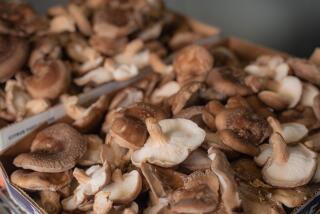Ever-Popular Mint Is Easy to Grow : Gardeners Tell How to Avoid Fungus, Excessive Spreading
- Share via
Perhaps you’ve noticed that mint, one of the most popular of all herbs, is conspicuously absent from seed catalogues. “That’s because they hybridize themselves so easily,” said Paul Taylor of Taylor Herb Gardens in Vista, Calif. To be certain of raising the particular variety desired, it’s better to buy small plants from a nursery or get one or two root divisions from a friend.
Taylor demonstrated how to do the latter by breaking off the top of a healthy plant below the third set of leaves. He then stripped off the lower leaves, leaving only the top cluster, and inserted the about 2-inch-long plant into sand that had been washed to remove all nutrients.
“That forces the plant to send out roots looking for food,” Taylor said. Mint also will develop roots in water, but it takes longer than if planted in sand.
Once rooted, mints prefer moist, fertile soil and partial shade. “Water mint as you would any other vegetable,” Taylor said, “but don’t soak it--that can cause rust.” Rust is a fungus disease that spreads from within the plant and eventually causes lower shoots to become contorted and speckled with orange. Although some books claim the only cure is to completely destroy the plants, Taylor said he has had success just cutting the plants to the ground.
Spreads by Stems
The other common problem in raising mint is containment. Left on its own, mint will quickly spread via creeping stems, rooting as it goes. Probably the easiest way to control this spreading is to grow mint in a container. Another suggestion is to bury a bottomless bucket or fence around the plant. The barrier should extend 8 or 10 inches into the soil, because mint stems travel underground, as well as on the surface.
Most mint grows upright, 2 to 3 feet high. Two exceptions are Corsican mint and pennyroyal, which are ground covers. Mints are perennials, and have four-sided stems and green leaves that can be round to oval and pointed at the tip. Flowers range from white to purple, depending on the variety. These should be picked off to encourage growth of the leaves and to help control spreading.
Still another way to keep mint in check is to cut it two or three times a year, leaving just a few inches of stem to grow again. Most books recommend changing the location of mint in the garden every four or five years.
Mints have been used for centuries as antiseptics and to aid digestion. The Greeks and Romans rubbed their tables with mint leaves before special meals so the fresh aroma would entice appetites.
Common Cooking Ingredient
Today, most people think of mint for jellies and juleps and as the traditional accompaniment to lamb. In the Middle East, however, mint is a common ingredient in cooking. It’s also used for teas, to accent vegetables and for flavorings and garnishes of fruit drinks, salads and desserts. Although it may be dried, most mint is used fresh.
The fact that mints hybridize easily has led to an almost infinite number of species and varieties--and to some confusion over descriptions. The following types are commonly found in area nurseries:
Apple--Often called “woolly mint” because of its soft grayish-green, slightly rounded, downy leaves. Blooms are pinkish-white or reddish to lilac. Very fruity fragrance and delicate spearmint-apple flavor. Recommended for tea and to garnish applesauce.
Corsican--A ground cover of tiny, round bright-green leaves with small mauve flowers. Grows well in shade and between steppingstones. Strong peppermint scent and rich flavor.
English--Dark-green leaves with a fresh clean fragrance. Good all-around culinary mint.
Mint the Best--Narrow, pointed green leaves with a spearmint flavor. The variety grows wild in California mountains and also is cultivated by Taylor Herb Gardens. Prone to rust fungus. Good all-around culinary mint.
Orange Bergamont--Green, branching stems tinged with red. Leaves are round to oval, smooth and dark-green with a red edge. Purple flowers. Very fragrant, citrus-like scent and flavor. Recommended for tea or punch.
Pennyroyal--Upright and ground cover varieties with small, rounded, glossy dark leaves and a strong peppermint scent. Purple-red flowers. Also known as “pudding grass” and “organie.” Pungent as peppermint, but with a coarser flavor. Not recommended for culinary use, as large amounts are said to be toxic.
Peppermint--Said to be a cross between water mint and spearmint. Two common varieties:
Black: purple-tinged, dark green leaves and stems. Purple flowers. Powerful peppermint scent and flavor. Recommended for tea.
White: grass-green stems and leaves and more delicate, though less oil. Violet flowers. Also recommended for tea.
Pineapple--Slightly downy, rounded, variegated green and cream leaves. Whitish-gray flowers. Refreshing fruity scent and flavor that becomes more minty with age. Recommended for garnishing fruit salads.
Spearmint--The most commonly grown culinary variety. May also be called “lamb mint,” “pea mint” or “garden mint.” Wrinkled, oval leaves that come to a point. Pale violet flowers. Prone to rust fungus. Recommended for mint sauce or juleps, jelly, tea, fruit salads or punch, or combined with carrots or peas.






